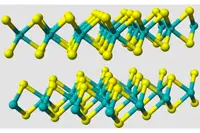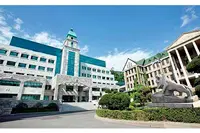Electronics News
Archive : 10 February 2015 год
 The number of applications requiring electronic devices which can resist high temperatures is growing and some, such as turbines and down hole sensing, need devices which can operate at temperatures of more than 200°C.
The number of applications requiring electronic devices which can resist high temperatures is growing and some, such as turbines and down hole sensing, need devices which can operate at temperatures of more than 200°C.
A team of researchers from the University of California, Riverside and Rensselaer Polytechnic Institute have discovered that molybdenum disulphide (MoS2) may be suitable for thin-film transistors for such extreme temperature applications.
"Our study shows that MoS2 thin film transistors remain functional to temperatures of at least 500K [220°C]," said Professor Alexander Balandin from UC-Riverside. "The transistors also demonstrate stable operation after two months of ageing."
Using standard lithography techniques, Prof Balandin's team built MoS2 transistors on silicon substrates. Some had a few layer, whilst others had up to 18 layers. The relatively thick films were more thermally stable and demonstrated a higher mobility at elevated temperatures, according to Prof Balandin.
By conducting direct current measurement, researchers studied the current-voltage characteristics or functional performance of the fabricated transistor at temperatures from 300K to 500K. They found the device performed differently, but remained functional as temperature increased.
"Mobility and threshold voltage decreased with temperature," Prof Balandin said.
Prof Balandin also noted: "Single layer MoS2 shows a band gap of 1.9eV, larger than that of silicon and gallium arsenide, and this is beneficial for the proposed application."
Author
Graham Pitcher
Source: www.newelectronics.co.uk
 Researchers from South Korea have developed a thin film that retains its electric and magnetic properties, even when highly curved.
Researchers from South Korea have developed a thin film that retains its electric and magnetic properties, even when highly curved.
According to the team, flexible electronics have been hard to manufacture because many materials with useful electronic properties tend to be rigid. The solution, says the team, is to take tiny bits of materials like silicon and embed them in flexible plastics.
However, rather than use silicon, the South Korean team has used bismuth ferrite – a multiferroic – whose electronic properties can be controlled by a magnetic field. Nanoparticles of bismuth ferrite were mixed in a polymer solution, which was dried to produce a thin, flexible film. When the film's electric and magnetic properties were tested, the team found the useful properties of bulk bismuth ferrite had been enhanced – and the improved properties remained when the film was curved into a cylindrical shape.
"Bulk bismuth ferrite has crucial problems for some applications, such as a high leakage current, which hinders the strong electric properties," said Professor Young Pak Lee from Hanyang University. Mixing nanoparticles of bismuth ferrite into a polymer improved the current-leakage problem, he said, and gave the film flexible, stretchable properties.
Flexible multiferroics could enable new wearable devices such, as health monitoring equipment or virtual reality attire, said Prof Lee, adding the multiferroric materials could also be used in high density, energy efficient memory and switches.
Author
Graham Pitcher
Source: www.newelectronics.co.uk
 HyperCatCity, a smart city initiative backed by technology companies, private organisations and public institutions, was launched last month. The initiative looks to exploit the HyperCat standard, unveiled last year to ensure that various IoT services and systems can work together more effectively. Supported by more than 250 organisations and multiple standards boards, HyperCat is intended to reduce the costs of systems integration and make the process of procurement simpler.
HyperCatCity, a smart city initiative backed by technology companies, private organisations and public institutions, was launched last month. The initiative looks to exploit the HyperCat standard, unveiled last year to ensure that various IoT services and systems can work together more effectively. Supported by more than 250 organisations and multiple standards boards, HyperCat is intended to reduce the costs of systems integration and make the process of procurement simpler.
The HyperCatCity initiative will enable businesses and cities to work together more effectively to deliver improved services using new applications and technologies. The project builds on an £8million investment from Innovate UK.
"Nobody wants to live in a 'smart city'," said Dan Byles MP, chairman of the All Party Parliamentary Smart Cities Group, speaking at the launch event. "Rather, people want to live in a city where their services are being delivered efficiently, where their streets are clean, where the transport systems work effectively and the energy is sustainable.
"If we're going to fully realise the smart city vision, we need to move beyond where we are at the moment – which is a series of discrete pilot projects which are in effect proving the concept, often with their own bespoke funding arrangements – to a point where this is simply the way we do things."
Justin Anderson, CEO of Flexeye, a leading participant in the HyperCatCity programme, said HyperCat offered 'a genuinely open interoperable non proprietary system that will help to lower the costs for businesses looking to enter into the IoT market'.
Among UK cities taking part are London, Bristol and Milton Keynes. Schemes under development include: smart parking; better traffic management; and the use of sensors to monitor and better manage recycling.
HyperCatCity will focus primarily on IoT solutions for energy, water, transport, waste and security and resilience management.
"With the rapid growth in urbanisation, both here in the UK and overseas, there is great potential for UK businesses to take leadership of this fast growing market," said Lord Erroll, chairman of HyperCatCity.
According to a BIS Research Paper (published in 2013) the global market for Smart City technology could be worth in excess of $400billion by 2020 and, with its strengths in design, research, finance and engineering services, the UK is well placed to seize a significant share of this fast growing market.
Figures from the Greater London Authority suggest that with a population expected to exceed 11million by 2050, the total investment in London's infrastructure between 2016 and 2050 could top £1.3trillion. The London Datastore, an official site set up to provide free access to a number of data-sets from the Greater London Authority, has 'HyperCat enabled' its data. As a result, it is now possible for anyone to build applications using that data.
Milton Keynes is set to use the initiative to accelerate its own 'Smart City Programme', the MK: SMART project, which is intended to gather real time information from a range of sources across the city to enable more efficient use of transport, water and energy infrastructures. Speaking at the launch Geoff Snelson, head of strategy at Milton Keynes Council, said: "The objective is to better use data by employing the latest technologies to resolve the constraints to growth for the city and to improve the quality of life of its citizens.
"Working with HyperCat City, we will be able to gain access to new research and innovative funding models."
Key strategic partners in the HyperCatCity project include: Arup, BIS, Bristol is Open, BSI, Future Cities Catapult, InnovateUK, Gartner, Milton Keynes, NESTA, techUK, the University of Surrey and the UKTI.
Author
Neil Tyler
Source: www.newelectronics.co.uk
 In a move said to underline the importance of security in IoT, ARM has acquired Offspark, a Dutch company which specialises in IoT communications security. According to ARM, the company's PolarSSL technology is already deployed in a range of devices, including sensor modules, communication modules and smartphones.
In a move said to underline the importance of security in IoT, ARM has acquired Offspark, a Dutch company which specialises in IoT communications security. According to ARM, the company's PolarSSL technology is already deployed in a range of devices, including sensor modules, communication modules and smartphones.
"We have always said that security must be the foundation of any IoT system and the acquisition of Offspark is evidence of us making that happen," said Krisztian Flautner, pictured, general manager of ARM's IoT business. "PolarSSL technology is already deployed by the leading IoT players. The fact that those same companies also use ARM Cortex processor and software technologies means we are now able to provide a complete bedrock solution for the industry to innovate from."
PolarSSL is a Transport Layer Security (TLS) solution and will form the core of the ARM mbed communication security and software cryptography strategy. Following the acquisition, the solution will be known as ARM mbed TLS. However, the technology will remain open source and available to developers for commercial use. ARM will release mbed OS under an Apache 2.0 license which will include mbed TLS, Thread, and other key technologies toward the end of 2015.
"ARM is undeniably the front runner in the embedded world and combining with it is the perfect way of scaling our business," said Paul Bakker, Offspark's CEO. "Security is the most fundamental aspect in ensuring people trust IoT technology and that is only possible with a truly tailored solution."
Author
Graham Pitcher
Source: www.newelectronics.co.uk

